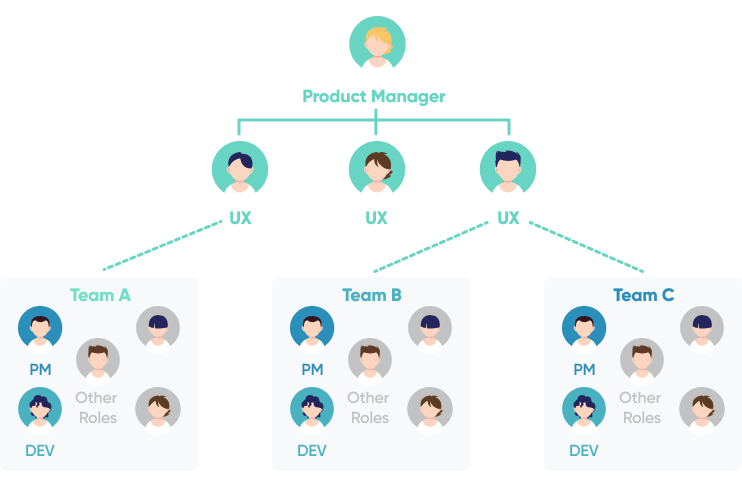The Product Management team brings an idea to fruition for what has been at the conceptual stage to that of the actual usage by the end-user. They ensure the products and services offered are aligning with the market requirements for serving the customer needs. The PM team is also responsible for maintaining its corporate goals at every stage of the product development cycle.
The role of the product manager is to guide and drive the team for the development, market launch and continue to develop newer products or improve the existing products of the company.
The structure and efficiency of the PM team define the quality of the product. The size of the PM team differs from one organization to another based on the size of the project to whom it may serve in the future. It may be noted that sometimes more than one product manager is assigned to the same project. Just as any successful project is backed by a great team, a PM team with clearly defined goals and job roles plays a vital role in contributing to the bottom line of the organization.
What is the product development team?
A product development team is a group of people who conceptualize and design the product based on customer needs and market requirements. They collaborate with other cross-functional smaller teams to create a new product design.
Organizations may choose different titles for job roles such as product manager, product owner, or business analyst and the functionalities contribute to a common outcome. For better collaboration, clearly defined roles and responsibilities help with good teamwork.
Some of the roles within the product team are as below:
- Management Team - creates the vision of the product or service and make the outline and design for developing a new product and the strategy for the same.
- Analytics Team - does the research on the current trends and needs, and requirements of the consumers, customers and the overall market.
- User Experience Team(UX) - creates product drafts, testing the usability, and research and monitor how users interact with it.
- Marketing Team - oversees the market launch and target audience to pitch in. They collaborate closely with other teams to help create a product that has maximum reach and increase the scope for new customers.

Core responsibilities of product team
The functionality of the product team can be categorized into three. Each of these teams is assigned a role and responsibility and they collaborate with each other. In the end, they contribute to the whole composite of Product Management for the organization.
- Product Vision gives the direction to think about what to create that will solve a problem for the end-user or how the solution may bring value to them. Vision sets in motion the activities of research of market needs, consumer preferences, and current trends that may need solutions to challenges that have still not occurred but that can be addressed as of today.
- Product Design gives shape to the vision to actualize a product. The customer interaction is ongoing to understand their needs with clarity and develop a product or service that brings value to their organizational goals. The design team researches other products in the market and draws unique product solutions.
- Project Management ensures the project moves with set timelines and goals that match the goals of the organization as a whole. Project Management comes under the purview of Product management and they oversee the communication with the customer and the product team for development.
Product team role within organizational structure
Depending on the organization structure, a product management team can have a vertical of its own. Research and development can be part of the product team for innovation. As such we may not be able to define a unified structure of a product team which is common across organizations. Some of the common product team roles and responsibilities are mentioned below:
- Creation of a new product and constant innovation in existing products.
- Market research for knowing a need for custom solutions.
- User research for usability and make changes when and where needed.
- Understanding consumer behaviors and mapping product solutions to suit their needs.
- Tracking similar product offerings and competitors.
- Creating buyer personas to market the product offering
- Marketing strategy and messaging in collaboration with the marketing team.
- Product launch and further service where needed.
- Collaboration with cross functional teams.
3 ways to structure product teams
Centralized product team

In a centralized model, all the UX design teams report to the same Product Manager. The titles may differ namely Chief Product Manager, Product Manager, Director of UX or any other title role which the organization defines. Typically, when a UX team is needed on a project, the product manager assigns his resource to the project for a certain period of time and the UX team, in turn, keeps reporting to the product manager. A UX team can be spread on a single product or multiple products. Once the project is complete the UX team reports back to the product manager for being assigned to another product or project.
Pros:
- High organizational investment in the UX team is possible with higher budget allocations and greater resources can be managed by the UX Manager.
- Better growth Opportunities for the UX team and even if they want to grow individually the options still exist.
- Sharing of knowledge and expertise within the UX team can produce a team of greater skills and expertise over time.
- Have the opportunity to work on multiple projects and still be under the oversight of a single Product Manager.
Cons:
- UX teams may not work on a single project for a longer period and hence miss the opportunities to be invited to strategy meetings and discussions through which they can participate as part of a team and grow extensively.
- The UX team may not be in the communication loop regarding new projects. They may or may not be retained in the same project.
- UX professionals are randomly utilized by different teams and hence lack the stability of intent in a project.
Decentralized product team

In this model, UX teams do not have a unified reporting manager but rather they report to managers they are aligned with on multiple projects or activities they are allocated to. They are widely known as ‘Pods’ in this structure with a smaller team size of around 10 people each. They are allocated to multiple teams and report to the product manager of that particular team or any other reporting authority. They tend to work on long-term projects with the same team.
Pros:
- The UX teams work on long-term projects and hence draw familiarity with other resource partners and work as a team. They are respected and trust is built over time.
- Greater exposure and can become experts in their line of work since they work long term and gain significant knowledge and experience in the product domain.
- Since they are here to stay, the UX team is involved in all team meetings, and strategic planning and is considered a stable resource as part of the product team.
Cons:
- UX teams may not be able to express dissent or confront when disagreements arise as they are outnumbered, and their say may be ignored or unheard.
- Since there is no UX management team and they are spread across as resources for many projects, there is no scope for improvement for UX process and systems within the organization. UX teams may remain outdated over a period.
- Since they are not under the command of a UX management team, they will lose the intent on research and development of UX processes and may continue to do work that is redundant and follow outdated processes.
Matrix design team structure

In this model, the UX team reports to the UX-Specific Manager and also the product manager they are assigned to. The weightage of communication depends on who they are closely working with, but the UX manager keeps an oversight on the UX teams across all functionalities they are assigned to.
Pros:
- There is greater UX focus from both the UX manager and the designated product manager.
- UX professionals get to work on long-term projects and are considered as part of the team by other functional product team members.
- UX professionals have a say in the product team activities as they are not left alone and have the oversight from their own UX Manager who supports their cause in case of disagreements or differences.
Cons:
- Many times it becomes tricky for the UX professional on whom to approach for their professional growth since they report to two working authorities.
- Unless there is better coordination between the UX manager and the product manager it becomes difficult for a UX professional to work harmoniously. In large organizations, a hybrid model works only when there are better processes and systems in place for shared authority and communication.
Which product team structure is best?
Among these typical structures, there isn't a best model. The decision to commit to one model over another should be driven by the overall organizational context (e.g., company size, product complexity, design team capacity vs. organizational demand). However, there are a few trends that have been noticed:
Typically, young teams inside design firms start off with a centralized structure. There are typically insufficient design and research staff to support a decentralized model at the time of team formation. Because there is now enough design talent to distribute among teams in a fixed fashion, as the size of a product team rises, usually in parallel with a rising demand for the skillset, the team may evolve into a decentralized model.
In-house product organizations, on the other hand, are frequently started with a distributed team. An individual team may hire a product designer if the necessity for product design is recognized.
Many organizations (agencies and in-house product companies alike) eventually adopt a matrix model over a period of time and lessons learnt. With this flexible, hybrid approach, an organization may strike a balance between the need to maintain consistent collaboration and alignment among the core product team and the long-term partnership between product and technical teams.
Consider the following factors when choosing which model is ideal for your team:
- The process currently in use. Are there any product design activities or checkpoints included in the present process? Otherwise, product design will be tough for anyone, but especially so for a single product designer on a decentralized engineering team. Due to a lack of resources and support, this person will spend a significant amount of time attempting to persuade the team to focus on product design.
- The number of products and product teams versus the size of the product design team. Is there a sufficient number of product designers to devote to each product team? Is it necessary to prioritize projects on a case-by-case basis? Which teams will have a product designer and which will not if a decentralized approach is appropriate but there are more product or scrum teams than product designers? Is it possible to make such a conclusion in a consistent and objective manner? A centralized model or matrix can serve as a custodian of product design allocation if project-by-project prioritizing is required.
- Delegation of design responsibility. Is there enough demand for product designers within individual product teams to justify hiring one? Will members of remote product teams find themselves twiddling their thumbs, wishing they could contribute to workstreams where their abilities are required?
- Product design maturity and culture. Will the knowledge and insights of distributed product design employees be appreciated equally to those of other members of individual product development teams?
Conclusion
Putting together a strong product management team structure is no easy decision. Determining the requirements of your team is difficult since you are continually seeking to enhance procedures and systems that allow you to provide the greatest experience to your consumers. This is certainly a challenge for product managers.
Select a team structure model that matches the context of what you are doing now, what you may want in the future, and what your product vision demands for the product to be successful. The structure should not be treated as an afterthought; it may make or destroy your product management efforts. Remember that only a well-structured and well-defined product management team can help you construct your product from the bottom up and get it to the level you desire.
Need to craft an end-to-end software application team? At SoftKraft we provide Software Product Development Services. We take project ownership and responsibility for decisions that were taken during the development. Success of the project is the only metric that really matters to us.

![Top 3 Product Team Structures — Which is the Best? [Pros & Cons]](/.netlify/images?url=_astro%2Fproduct-team-structure.DxnvOFRm.png)




![Product Validation — 12 Ways to Test Your Product [with Examples]](/uploads/blog/product-validation/product-validation.png)
